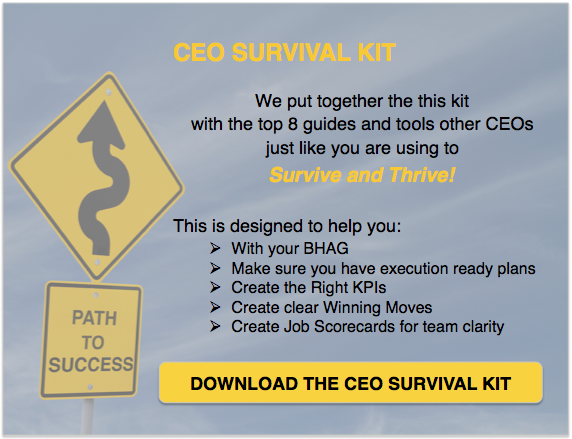There’s a chain reaction at the root of most organizational chaos. The catalyst is lack of focus. Without a  clear definition of what’s most important, people (including leaders) don’t understand what deserves attention or why. Instead, people operate based on a multitude of assumptions about what they think is most important. When this happens in a company, the default mode is to react to what’s going on at any given moment on any given day. Without discipline, every opportunity is a shiny object to be chased —and trust me, there will always be plenty of bright shiny objects to reach for.
clear definition of what’s most important, people (including leaders) don’t understand what deserves attention or why. Instead, people operate based on a multitude of assumptions about what they think is most important. When this happens in a company, the default mode is to react to what’s going on at any given moment on any given day. Without discipline, every opportunity is a shiny object to be chased —and trust me, there will always be plenty of bright shiny objects to reach for.
The intent is almost always positive but the frustration of a leader constantly leap-frogging from one thing to another causes the entire organization to function without any real sense of alignment. This results in wasted effort, harder work for less progress, no clarity on what success looks like, and no one knowing who’s accountable for what.
What emerges is a culture of chaos, competition, and mere survival. For companies facing this challenge, the lack of clearly stated strategic priorities makes everything a moving target, which makes it difficult to “see” what isn’t working as well as it should. The next thing you know, you’ve lost a key account or a core customer, or you’ve sacrificed a great opportunity for a smaller one, which pulls your focus and energy away from long-term meaningful goals that will support the company’s sustainability and market viability.
Tips for Taming the Chaos
If you’re feeling the pain of chaos (or simply if projects just don’t seem to be gaining the traction you need them to), then review the tips below. Rank yourself on each one (1=Rock Bottom; 5=Mediocre; 10=Excellence) and then work to address those that rank lower.
- Use the BHAG test. Do you have a compelling longer-term Vision? (If not, you need to work on one.) Choose the one or two opportunities that will take you closer and faster to your BHAG, or eliminate threats or obstacles that could keep you from your BHAG.
- Create strong Winning Moves. Do you know the bigger initiatives that need to get done over the next 3-5 years so you’ll be positioned to leverage your growth? These bigger mechanisms are Winning Moves and they’re your 3-5 year initiatives. If your BHAG is to climb Mt. Everest, then your Winning Moves are the base camps up that mountain. They are specifically identified by you and your leadership team as longer-term revenue generators for the company (and they usually take 3-5 years to complete). Therefore, what must happen this year in order for you to execute your Winning Moves and grow the company toward your longer-term BHAG? Where do you need to be in 3-5 years?
- Discuss, debate, agree. How often do you have truly focused and aligned strategic discussions around what’s most important to the company? Even with the BHAG test and a strong Winning Moves discussion, you may have a lot of great ideas. Discuss, debate, and agree on the possibilities with your team, taking the time to have productive conversations that lead to better, smarter decisions. Once you’ve discussed, debated, and agreed, then specifically identify what you’re going to do (clearly identifying who’s going to do it as well as the criteria for what success looks like).
- Don’t accept mediocrity or vague plans. Be as specific as possible. For each annual initiative (and/or for each quarterly priority), who’s accountable for making sure each initiative is moving? What are your Red, Yellow, Green, SuperGreen success metrics for each initiative?
- Know when to cut your losses. If something is Red, why? Brainstorm what barriers need to be removed, what process(es) need to be streamlined to expedite success or reassess the initiative altogether. There are times when you want something, but its lack of forward movement may indicate that you need to spend your energy elsewhere. There are times when you need to cut the cord on a “favorite” initiative. Cut your losses, replace it with something more feasible, and move forward.
- Keep the execution of your strategy focused and aligned. You can’t go from 0-120 mph without focus and alignment. At your Weekly Adjustment Meetings, status progress on each KPI and on each quarterly priority and talk about what’s going well and what’s not going well. What can be done? What are we learning? By keeping the execution of your strategy focused and aligned, you create clarity, trust, and a sense of urgency—all with a strong sense of purpose.
- Identify the roadblock(s) to productivity. Keep in mind that many times a major roadblock is a leader’s style of leadership. Hold your leaders accountable for being effective leaders that guide and coach their people to success.
- Create transparency. To what degree do you feel there is a strong sense of transparency in your company? If something’s “Red,” it isn’t the person that’s Red; it’s the initiative or quarterly priority that’s Red. Create transparency (which is very uncomfortable for many leaders) so you and your team can have the difficult discussions. Growth isn’t easy; it’s hard work. Without facing the truth, no matter how ugly the truth is, you almost guarantee limited results. Create an environment where talking, openly and constructively, about the hard stuff is the norm.
Photo Credit: iStock by Getty Images
Photo Credit: iStock by Getty Images



 LinkedIn
LinkedIn
 Facebook
Facebook


